
Balmoral Castle is a large estate house in Aberdeenshire, Scotland, and a residence of the British royal family. It is near the village of Crathie, 9 miles (14 km) west of Ballater and 50 miles (80 km) west of Aberdeen.

Dumbarton Castle has the longest recorded history of any stronghold in Scotland. It sits on a plug of volcanic basalt known as Dumbarton Rock which is 240 feet (73 m) high and overlooks the Scottish town of Dumbarton.

Sunnyside (1835) is a historic house on 10 acres along the Hudson River, in Tarrytown, New York. It was the home of the American author Washington Irving, best known for his short stories, such as "Rip Van Winkle" (1819) and "The Legend of Sleepy Hollow" (1820).
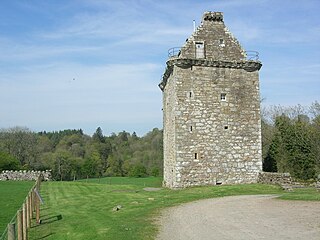
Gilnockie Tower is a 16th-century tower house, located at the hamlet of Hollows, 2.3 km north of Canonbie, in Dumfries and Galloway, south-west Scotland. The tower is situated on the west bank of the River Esk. It was originally known as Hollows Tower.
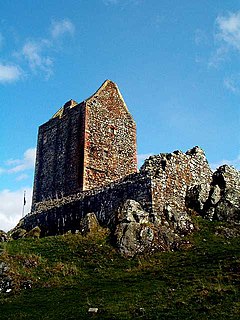
Barmkin, also spelled barmekin or barnekin, is a Scots word which refers to a form of medieval and later defensive enclosure, typically found around smaller castles, tower houses, pele towers, and bastle houses in Scotland, and the north of England. It has been suggested that etymologically the word may be a corruption of the word barbican or berm. The barmkin would have contained ancillary buildings, and could be used to protect cattle during raids.

Clan Irvine is a Scottish clan.

Robgill Tower is a tower house near Ecclefechan on the banks of the river Kirtle. It was one of a number of towers built along the border as protection against incursions by the English.
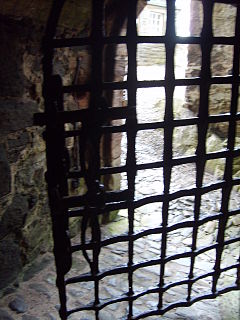
A yett is a gate or grille of latticed wrought iron bars used for defensive purposes in castles and tower houses. Unlike a portcullis, which is raised and lowered vertically using mechanical means, yetts are hinged in the manner of a traditional gate or door, and secured by bolts attached to the yett, or by long bars drawn out from the wall or gateway.

Abbot's Tower is a late-16th-century tower house situated near New Abbey, Dumfries and Galloway, Scotland, that was built by the Abbot of Sweetheart Abbey. The building was restored in the early 1990s and is now used as a private residence and as a bed and breakfast. This structure should not be confused with the Abbot's Tower of Alnwick Castle.
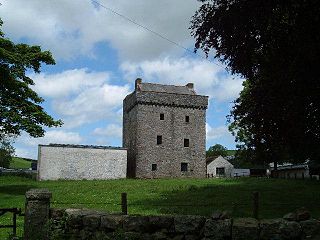
Drumcoltran Tower is a late-16th-century tower house situated in the historical county of Kirkcudbrightshire near Kirkgunzeon, Dumfries and Galloway.

Edingham Castle is a late 16th-century tower house situated near Dalbeattie, Dumfries and Galloway. It is the remains of an early tower house built for the Livingstones of Little Airds. It is near Edingham Munitions Factory and is a scheduled ancient monument.

Lochhouse Tower is a mid-16th-century tower house situated near Moffat, Dumfries and Galloway. It was restored in the late 1970s and is now used as a private residence.

Auchenskeoch Tower is a 17th-century tower house situated in Dumfries and Galloway, south-west Scotland. It is near Dalbeattie in the civil parish of Colvend and Southwick, in the county of Kirkcudbrightshire. It is thought to be built on a Z-plan, making it the only such tower in Galloway. Dalswinton Tower in the neighbouring county of Dumfriesshire is the only other example in Dumfries and Galloway. The remains of the tower are within the modern Castle Farm and are a scheduled ancient monument.
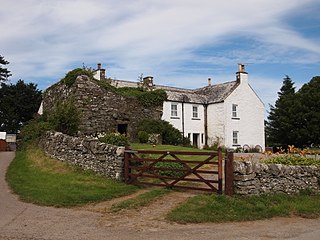
Balmangan Tower is a ruined 16th-century tower house situated near Borgue, Dumfries and Galloway.
Barclosh Castle is a ruined 16th-century tower house situated near Dalbeattie, Dumfries and Galloway. There remains a section of wall 4 feet thick and 27 feet high.
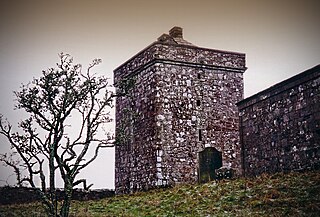
The Repentance Tower is a very rare example of a mid-16th century watch tower standing on Trailtrow Hill, six miles north-west of Annan, Dumfries and Galloway. Built in 1565 by John Maxwell, the tower takes its name from an inscription Repentance carved on the stonework above the entrance door.
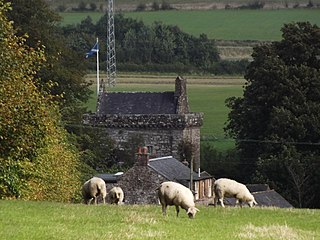
Bonshaw Tower is an oblong tower house, probably dating from the mid-16th century, one mile south of Kirtlebridge, Dumfries and Galloway, Scotland, above the Kirtle Water. It is adjacent to a 19th-century mansion. The tower was one of a number of structures built along the Scottish border in the 1500s as protection against incursions by the English.
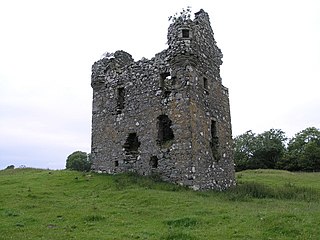
Plunton Castle is a ruined L-plan tower house between Kirkandrews and Gatehouse of Fleet in Dumfries and Galloway, Scotland. Built around 1575 for the Lennoxes of Plunton, it passed by marriage to the Murrays of Broughton in the late 17th century. It was still inhabited in 1684, when it was described by Reverend Symson in his Large Description of Galloway as "a good strong house", but by 1838, when it was painted by George Colomb, it had been abandoned and had fallen into a ruinous condition.
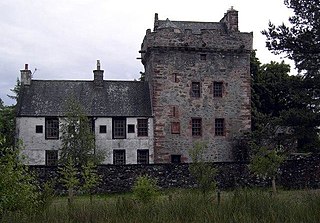
Hills Tower is a sixteenth-century square tower house, with an adjoining eighteenth-century wing, near Dumfries in Scotland. Originally built around 1527 for Edward Maxwell, who had purchased the estate from James Douglas of Drumlanrig, it was improved in the later sixteenth century by his grandson, also Edward Maxwell. In 1721, another Edward Maxwell had a two-storey Georgian wing added to the tower's east side, using stone taken from older buildings nearby, and incorporating armorial panels celebrating members of the Maxwell family.
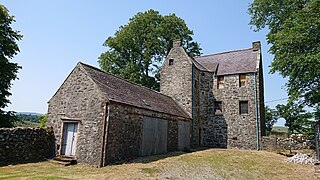
Earlstoun Castle, sometimes spelled Earlston Castle, is a derelict tower house near St John's Town of Dalry in Dumfries and Galloway, Scotland. Built in the late sixteenth century, it was home to members of the Gordon family, including William Gordon of Earlston who was killed at the battle of Bothwell Bridge. It is unusual for a tower house of its age for its lack of defensive arrangements: it has no gun loops, its roof is without a parapet or corner turrets, and it lies in open ground without natural defences.




















